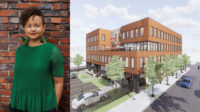Architectural Emblems of Kazakhstan's Energy Wealth

Architectural Emblems of Kazakhstan
The Boston-based firm Koetter, Kim & Associates is creating a master plan for a massive expansion of Aktau, a city originally developed by Soviet Russia to support oil drilling in the Caspian Sea.
Image courtesy Koetter, Kim & Associates

Architectural Emblems of Kazakhstan
The Boston-based firm Koetter, Kim & Associates is creating a master plan for a massive expansion of Aktau, a city originally developed by Soviet Russia to support oil drilling in the Caspian Sea.
Image courtesy Koetter, Kim & Associates

Architectural Emblems of Kazakhstan
Foster + Partners tent-like Khan Shatyr Entertainment Centre has a fabric skin suspended from a 500-foot mast.
Image courtesy Foster + Partners

Architectural Emblems of Kazakhstan
Foster + Partners’ tent-like Khan Shatyr Entertainment Centre has a fabric skin suspended from a 500-foot mast.
Image courtesy Foster + Partners

Architectural Emblems of Kazakhstan
Foster + Partners’ tent-like Khan Shatyr Entertainment Centre has a fabric skin suspended from a 500-foot mast.
Image courtesy Foster + Partners

Architectural Emblems of Kazakhstan
Foster + Partners’ tent-like Khan Shatyr Entertainment Centre has a fabric skin suspended from a 500-foot mast.
Image courtesy Foster + Partners


